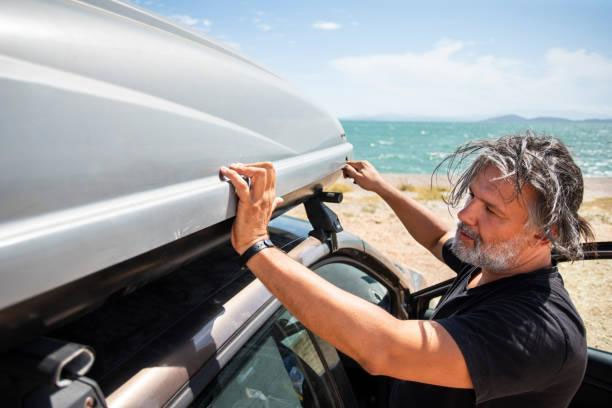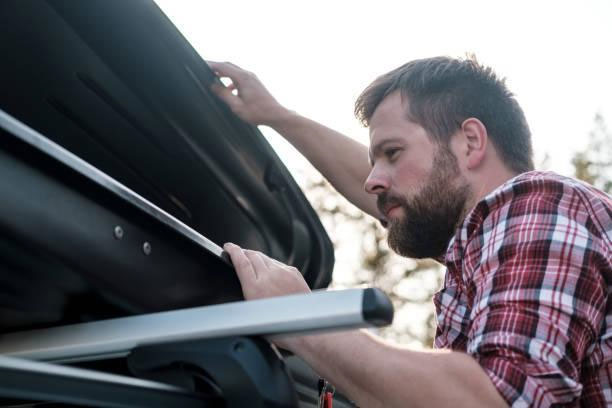If you need extra storage to carry your camping gear and other accessories, the roof box should be an ideal installation for your car. Moreover, protecting your gear from direct weather impact is necessary, especially if you are going out as a family.
To create more room inside the car, the roof box can contain more items, including clothes, food, suitcases, and other bulky items. If you are an outdoor enthusiast, it is one of the essentials your car should never miss.
For effectiveness, you should carefully install a roof box to ensure the weight is equally distributed and it remains firm enough when driving. Failure to do so could be a nightmare as it is one of the safety hazards and can also impact other activities such as speed and braking.
Therefore, before you install it, have all the necessary and right gear you need for the job. Next, consider some of these tips to secure it in position safely and venture on your trips without worries.

1. Securing the Cross Bars
The crossbars are essential to holding the rack on the roof and ensuring it is firm even when driving on rough roads and at high speed. Moreover, the roof box can sometimes be heavy due to extra luggage; hence, it is easier for the weight to overwhelm the crossbar, leading to accidents.
Therefore, the first process is to select the right crossbars that perfectly fit on the car roof and can withstand the box’s weight and movement. The ideal crossbar should be firm, steady, and sturdy to accommodate the box weight and stay in place.
Normally, the bars are made of different materials; however, the type of roof rack storage you want to install will impact your decision to select the right one.
Once you have the right roof cross bars, ensure they are tightened into position and firmly secured to the door’s archway. Before installing the bars, ensure the car has a crossbar setup to allow easy installation and fixing. The distance between the bars should be close to allow them to bear the box's maximum weight instead of all that weight pressed on the car roof.

2. Installing Extra Safety Gear
If you have a smaller car roof and the box is slightly bigger, you could benefit from additional safety gear to fasten the box to the roof and hold it steady. This can be achieved by attaching extra safety and grip gears to the crossbar to enable you to fasten the box once it is fully loaded.
Extra locks and fastening belts will be handy when you drive downhill, and the box will likely slide forward.
3. Positioning the Roof Box
One of the concerns you must address is the right position for the roof box while taking into account gravity, winds, visibility, and aerodynamics.
Locating the box towards the front affects aerodynamics, slows down the car, and is likely to trigger wind impacts to blow off the box from the roof. This can also affect your visual clearance; therefore, the box should be slightly located towards the back but not too much.
Ensure the weight is distributed equally on the roof and most of the weight impact is centrally located.
Whenever you install the box too much at the front or the back, you interfere with the center of gravity, which can easily lead to the box or the car tilting. Also, do not locate the box where it can easily affect access in and out of the car by blocking the door.
Ensure a bulk of the weight is centrally located so that the center of gravity is at the center of the car’s roof. This is ideal for stability and safety and avoiding the box from swerving during high winds or when driving down rough roads.
To limit the impact of the drag, ensure the box is closer to the roof; the bottom part should have a few inches of clearance from the roof. This is to allow air passage and avoid the direct impact of the air on the box.
If the bottom part is on the car’s roof, you risk damage to the roof; worse, you risk affecting airflow, creating a speed obstacle slowing the car down.
All these dynamics are determined by how you position your crossbars on the roof before mounting the box. There is enough space to open and close the door when centrally placed.

4. Safety Consideration When Installing the Box
A roof box is one of the biggest hazards for your car, especially when not safely located and installed in place. The first measure is to consider the impact of such weight on the car. Not all car roofs are designed for any box; hence, you must select a lighter one.
Also, consider the cargo capacity and what that weight could do to the car roof. Such consideration will guide your decision on selecting the right cross bars to carry all the weight without burdening the car roof.
Also, do not buy too high boxes since that can affect your clearance when entering limited spaces like garages. Whenever the box is ripped off from the car, the roof will have some impact; hence, you must be careful. The material you use to secure the box to the car roof should be weather, corrosion, and rust-resistant. This will avoid any subsequent rust to the roof or damage to the paint.

Conclusion
Before installing the roof box, the first consideration should be safety; hence, you need to ensure you have all the necessary features to secure the box in position.
Next, select the right crossbars to bear the box’s weight and prevent the box from resting on the car roof. The location and type of bar to select should depend on the car roof and the type of storage box to carry.







